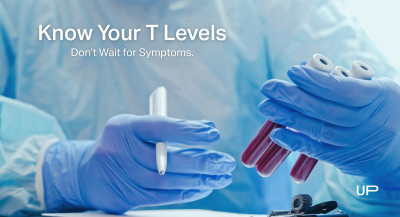Signs And Symptoms Of Low Testosterone: Do You Need TRT?


As men reach their forties and fifties, changes in energy, mood, motivation, sleep, and body composition often become more noticeable.

Many Canadian men are left wondering whether these shifts are simply a normal part of aging or signs of low testosterone. Since testosterone levels naturally decline over time, it can be difficult to know when symptoms are worth paying attention to and when it may be time to get tested.
This is also why more men are asking whether they might need testosterone replacement therapy (TRT) in Canada.
Symptoms like fatigue, reduced libido, increased belly fat, or difficulty staying focused can overlap with stress, poor sleep, or lifestyle changes, making it tricky to identify the real cause. Understanding the signs of low testosterone is the first step toward a clear answer.
In this guide, we break down the most common symptoms of low testosterone, explain how they differ from normal aging, and outline what Canadian healthcare providers typically look for when deciding if TRT is appropriate.
Topics covered in this article:
- Key Takeaways (1-Minute Summary)
- What Causes Low Testosterone in Men Over 40
- Common Signs and Symptoms of Low Testosterone
- Red Flags That Suggest You Should Get Tested
- What Is Normal Testosterone vs Low Testosterone?
- Do These Symptoms Always Mean You Need TRT?
- When TRT May Help: What Healthcare Providers Look For
- When TRT Is Not Recommended
- How to Get Evaluated for Low Testosterone in Canada
- Conclusion: Take Charge of Your Testosterone Health
- Frequently Asked Questions
- References
Key Takeaways (1-Minute Summary)
- Testosterone levels naturally decline after age 40, but some men experience a sharper drop that leads to noticeable symptoms.
- Common signs of low testosterone include fatigue, low libido, reduced strength, increased belly fat, mood changes, brain fog, and poor sleep.
- Symptoms alone cannot confirm low testosterone, since stress, poor sleep, and lifestyle factors can cause similar issues.

- A proper diagnosis requires morning bloodwork and evaluation by a healthcare provider in Canada.
- TRT in Canada is only recommended when symptoms and labs clearly show low testosterone.
- Many men improve through a combination of lifestyle changes, better sleep, and medical guidance, whether or not TRT is needed.
- Understanding the signs early helps men decide if it is time to get tested and talk to a provider about their hormone health.
What Causes Low Testosterone in Men Over 40
Testosterone naturally dips with age, but for some men, the decline is faster or more significant than expected. These changes can influence energy, mood, sleep, and metabolism, which is why many men start questioning their hormone levels after 40. Understanding the common causes helps clarify whether symptoms are due to normal aging or something more.
Natural Age-Related Decline
Testosterone production slowly decreases each year after about age 30 to 35. This decline is expected, but in some men, the drop is steep enough to create noticeable symptoms such as low energy or reduced libido. Age alone does not guarantee low testosterone, but it increases the likelihood.
Lifestyle Factors
Habits that strain the body can lower testosterone levels over time.
These include:
- Lack of physical activity
- Diets high in processed foods or sugar
- Excess body fat, especially around the abdomen
- High alcohol intake
Improving these areas often helps stabilize hormonal balance.
Chronic Stress
High stress levels elevate cortisol, a hormone that suppresses testosterone production.
Ongoing stress from work, family, or financial pressure can create hormonal imbalances that gradually worsen energy, mood, and sleep.
Poor Sleep
Sleep plays a major role in testosterone production.
Low testosterone can result from:
- Short sleep duration
- Frequent nighttime waking
- Sleep apnea
Many men see significant improvements in hormone levels when sleep improves.
Obesity and Weight Gain
Excess body fat affects testosterone by increasing estrogen production and reducing hormone synthesis.
Visceral fat, the type stored around the abdomen, is especially linked to lower testosterone levels.
Medical Conditions and Illness
Certain health conditions can also reduce testosterone, including diabetes, thyroid issues, liver disease, and hormonal disorders.
In these cases, treating the underlying issue may help normalize levels.
Understanding these causes gives men a clearer picture of why symptoms appear and when it may be time to get tested.

Common Signs and Symptoms of Low Testosterone
Low testosterone affects different men in different ways, and symptoms often appear slowly, which makes them easy to overlook or attribute to stress or aging. Recognizing these patterns early can help men decide whether it’s time to get tested and talk to a provider about possible low testosterone or whether testosterone replacement therapy (TRT) in Canada may eventually be appropriate.
Below are the most common symptoms Canadian healthcare providers look for when evaluating low testosterone.
Low Energy and Persistent Fatigue
Many men with low testosterone describe feeling tired even after a full night of sleep.
Common signs include:
- Afternoon crashes
- Reduced stamina throughout the day
- Difficulty starting or finishing tasks
Reduced Libido and Sexual Performance Changes
Low testosterone can affect sexual desire and, for some men, erectile function.
This may look like:
- Less interest in sex
- Difficulty maintaining arousal
- Feeling “not like myself” sexually
Mood Changes and Irritability
Hormones play a major role in emotional regulation.
Men with low levels may notice:
- Irritability
- Low mood
- Less patience
- Feeling more stressed than usual
Increased Belly Fat and Weight Gain
Lower testosterone often shifts fat storage toward the midsection.
Men may experience:
- A softer stomach
- Tightening waistbands
- More difficulty losing fat even with effort
Loss of Muscle Mass and Strength
Testosterone supports muscle building and maintenance.
Low levels can lead to:
- Reduced strength
- Slower recovery
- Muscle appearing “flatter” or less defined
Brain Fog and Poor Concentration
Many men report cognitive changes with low testosterone, such as:
- Difficulty focusing
- Forgetfulness
- Slower processing or reaction times
Sleep Disturbances
Low testosterone can worsen sleep quality, and poor sleep can further lower testosterone — creating a cycle.
Common issues include:
- Waking frequently
- Feeling unrefreshed in the morning
- Difficulty falling asleep
Lower Motivation and Drive
Testosterone influences motivation and a sense of initiative.
Men may notice:
- Less interest in hobbies or goals
- Reduced drive at work
- Feeling less “on it” day to day
These symptoms do not confirm low testosterone on their own, but recognizing them early helps men understand when it may be time to consider testing and discuss their concerns with a healthcare provider.
Red Flags That Suggest You Should Get Tested
Some symptoms of low testosterone can be subtle, but others are strong indicators that your hormone levels may be below normal. These red flags are the ones healthcare providers in Canada take most seriously when evaluating whether a man might benefit from bloodwork or a closer look at his overall hormone health.
If you notice several of the signs below, it may be time to schedule a test.
- A Noticeable Drop in Libido: A sudden or long-lasting decline in sexual desire is one of the most common signs of low testosterone. When libido changes become persistent, it often signals a hormonal imbalance.
- Persistent Fatigue That Does Not Improve With Rest: Feeling constantly drained, even after good sleep, is a classic warning sign. If daily tasks feel harder or stamina has significantly declined, testosterone may be part of the issue.
- Difficulty Losing Belly Fat Despite Effort: Men with low testosterone often experience stubborn abdominal fat that does not respond to diet or exercise. This type of weight gain is strongly linked to hormonal changes.
- Significant Loss of Strength or Muscle: If you are losing muscle faster than expected or struggling to maintain strength, low testosterone could be affecting your ability to build and keep lean mass.
- Erectile Changes Along With Low Libido: While erectile dysfunction can have many causes, it becomes more concerning when paired with reduced libido, fatigue, or mood changes.
- Mood Shifts That Affect Daily Life: Irritability, lower stress tolerance, or feeling more emotional than usual can indicate that testosterone levels are lower than they should be.
- Sleep Issues Combined With Daytime Sluggishness: Trouble falling asleep or waking frequently at night, followed by low energy the next day, may point toward a hormonal imbalance.
- Multiple Symptoms Appearing at the Same Time: When three or more of these red flags appear together, providers are much more likely to recommend testosterone testing.
Recognizing these signs early helps men decide whether it is time to get their hormone levels checked and discuss next steps with a healthcare provider.

What Is Normal Testosterone vs Low Testosterone?
Understanding what counts as “normal” testosterone can be confusing because different labs, provinces, and healthcare providers in Canada use slightly different reference ranges. This is why symptoms, medical history, and proper timing of bloodwork all matter just as much as the numbers themselves.
Typical Reference Ranges
Most Canadian labs list total testosterone roughly within these ranges:
- Normal: About 10 to 30 nmol/L
- Borderline or Low-Normal: About 8 to 12 nmol/L
- Low Testosterone: Below about 8 nmol/L
These ranges are not exact for every lab. Some use slightly higher or lower cutoffs, and each man’s “optimal” level may vary based on age, health, and symptoms.
Why Ranges Can Differ
Lab reference values are based on population averages, not on what feels best for an individual man. Some Canadian providers consider both total and free testosterone, along with SHBG, since these give a more complete picture of how much testosterone is actually available for your body to use.
Why Morning Testing Matters
Testosterone is highest in the morning, especially between 7 and 10 a.m.
Testing later in the day can produce lower numbers and may not reflect your true baseline.
Symptoms + Bloodwork = Diagnosis
Levels alone do not confirm whether you need TRT. Healthcare providers in Canada look for a combination of:
- Persistent symptoms
- Repeat morning tests
- Consistently low levels on multiple markers
- Other health conditions that may be contributing
This combined approach helps avoid misdiagnosis and ensures men get the right treatment if TRT is appropriate.
Understanding how testosterone is measured and why the numbers vary helps take the confusion out of lab results and gives men more confidence when discussing next steps with a provider.
Do These Symptoms Always Mean You Need TRT?
Not necessarily. Many of the symptoms linked to low testosterone can also be caused by stress, poor sleep, weight gain, overwork, or other health issues. This is why healthcare providers in Canada avoid diagnosing low testosterone based on symptoms alone. Even if a man has several signs of low T, it does not automatically mean his levels are truly low or that TRT is the right treatment.
Some men also discover that their symptoms improve through better sleep habits, exercise, reduced alcohol intake, or treating an underlying condition like thyroid imbalance or sleep apnea. Others may have borderline testosterone levels that still fall within the normal range for their age.
This is why a proper evaluation matters. Bloodwork, symptoms, and medical history all need to line up before testosterone replacement therapy (TRT) is recommended. Getting tested is the only way to know for sure whether hormones are playing a role in how you feel.
When TRT May Help: What Healthcare Providers Look For
TRT is not prescribed based on symptoms alone. In Canada, healthcare providers follow clear medical criteria to determine whether testosterone replacement therapy is appropriate. The goal is to treat men who truly have low testosterone, not those experiencing temporary changes due to stress, lifestyle, or poor sleep.
Here is what clinicians typically look at when deciding if TRT may help:
Consistently Low Morning Testosterone Levels
TRT is usually considered when a man has:
- Two separate morning tests showing low or borderline-low levels
- Additional markers, such as free testosterone or SHBG, that support the diagnosis
This ensures the results reflect the true baseline.
Symptoms That Clearly Match Low Testosterone
Providers look for a strong pattern of symptoms such as low libido, persistent fatigue, reduced strength, abdominal fat gain, and low motivation. When these symptoms line up with low lab results, TRT becomes a more likely option.
No Untreated Health Issues That Could Be Causing Symptoms
Before starting TRT, providers often rule out other causes like thyroid problems, major stress, severe sleep issues, depression, medication side effects, or uncontrolled diabetes. Treating these first may resolve the symptoms without needing TRT.
A Clear Health Benefit Expected From Treatment
Some men see meaningful improvements in mood, energy, sexual health, and body composition when testosterone levels are truly low. In these cases, TRT can be a safe and effective part of long-term hormone care.
When symptoms, lab results, and overall health history all point in the same direction, TRT may provide support and relief. A proper medical evaluation ensures the treatment is both safe and necessary.
When TRT Is Not Recommended
Testosterone replacement therapy is not right for everyone. Even if a man has symptoms that feel hormonal, TRT may be unsafe or unnecessary depending on his medical history, lab results, or current health conditions. Canadian healthcare providers follow specific guidelines to protect patients and ensure that TRT is used only when it is medically appropriate.
Here are the situations where TRT is generally not recommended:
Normal Testosterone Levels on Repeat Testing
If bloodwork shows that your testosterone levels are within a healthy range for your age, providers will not prescribe TRT. Symptoms in this case are usually caused by lifestyle, stress, sleep problems, or other medical issues that must be addressed instead.
Men Trying to Conceive
TRT can significantly reduce sperm production.
Men who want to maintain or improve fertility should avoid TRT unless they are working with a specialist who offers alternatives that protect sperm count.
Untreated Sleep Apnea
Sleep apnea can worsen with TRT if it is not properly managed. If a provider suspects undiagnosed sleep apnea, they will likely recommend testing or treatment before considering hormone therapy.
Certain Medical Conditions
TRT may be unsafe for men with:
- Active prostate or breast cancer
- Uncontrolled heart failure
- Very high red blood cell counts
- Severe, untreated mental health conditions
These situations must be managed before TRT can even be considered.
Symptoms Without Lab Confirmation
Some men have symptoms that feel hormonal but still have normal testosterone levels. In these cases, TRT will not help and could make things worse. Treatment needs to target the real underlying issue instead of hormones.
Avoiding TRT when it is not medically appropriate protects long-term health and ensures that men who do need treatment receive it safely. Proper diagnosis and monitoring help prevent unnecessary risks.
How to Get Evaluated for Low Testosterone in Canada
If you recognize several symptoms of low testosterone, the next step is to get properly evaluated. In Canada, the process is straightforward, but it must be done correctly to get accurate results. This helps your healthcare provider determine whether low testosterone is truly the cause of your symptoms and whether testosterone replacement therapy (TRT) is appropriate.

1. Complete an Initial Assessment
Most providers begin with:
- A symptom review
- A medical history questionnaire
- A discussion about sleep, stress, medications, alcohol use, and lifestyle
This helps rule out non-hormonal causes and ensures bloodwork is necessary.
2. Get Morning Bloodwork
Testosterone must be tested between 7 and 10 a.m. for the most accurate reading.
Your provider will typically order:
- Total testosterone
- Free testosterone
- SHBG
- Sometimes estradiol or other markers
This combination gives a clear picture of hormone balance.
3. Repeat Testing to Confirm Results
If your first test is low or borderline, providers often repeat the bloodwork on a different morning to confirm the result. This prevents misdiagnosis caused by temporary fluctuations.
4. Review Results With a Healthcare Provider
A licensed Canadian provider will interpret your results, compare them with your symptoms, and consider other factors like sleep quality, stress levels, and body weight.
5. Discuss Whether TRT Is Safe and Suitable
If your testosterone is consistently low and your symptoms match, your provider may recommend TRT.
If not, they may suggest lifestyle changes, sleep improvements, or further testing.
Getting evaluated the right way ensures you receive a proper diagnosis and safe, evidence-based care. It also helps identify whether TRT is the right step or if there are other, more effective ways to address your symptoms.
Conclusion: Take Charge of Your Testosterone Health
Understanding the signs and symptoms of low testosterone helps men take control of their health instead of guessing whether their fatigue, low motivation, or changes in body composition are simply part of aging. While many of these symptoms can overlap with stress, sleep issues, or lifestyle habits, getting tested is the only way to know for sure.
Canadian healthcare providers rely on a combination of symptoms, proper morning bloodwork, and medical history to determine whether testosterone replacement therapy (TRT) is appropriate. For some men, TRT can make a meaningful difference in energy, sexual health, strength, and overall well-being. For others, lifestyle changes or sleep improvements may be enough to restore balance.
The most important step is not to wait until symptoms worsen. If you recognize several of the signs discussed in this article, consider getting evaluated and talking to a licensed provider. You deserve clear answers and a plan that supports your long-term health.
Frequently Asked Questions
Yes, if your testosterone levels are truly low and your symptoms are related to hormone imbalance. Men often see improvements in energy, libido, mood, and strength. Results vary based on age, health, and how well treatment is monitored.
Absolutely. High stress and poor sleep can lower testosterone temporarily and produce similar symptoms. This is one reason testing and proper evaluation are important before starting treatment.
Yes. Better sleep, regular strength training, weight loss, and reduced alcohol intake can improve hormone balance. Some men see noticeable improvements without needing TRT.
TRT can support fat loss in men who have clinically low testosterone, especially around the abdomen. It is not a standalone weight loss treatment but can complement lifestyle changes.
No. TRT should not be used for general wellness or physical enhancement when levels are normal. Providers in Canada only prescribe TRT when bloodwork and symptoms both indicate low testosterone.
Most men notice improvements within a few weeks, especially in energy and libido. Body composition changes, strength gains, and mood improvements often take several months.
Many men stay on TRT long term, but it depends on the cause of low testosterone. Some men can stop treatment if an underlying issue improves. A provider will guide you based on your results and overall health.
When prescribed responsibly and monitored with regular bloodwork, TRT is considered safe for most men with clinically low levels. Monitoring helps ensure red blood cell counts, estrogen levels, and other markers stay in a healthy range.
References
UPGUYS has strict sourcing guidelines to ensure our content is accurate and current. We rely on peer-reviewed studies, academic research institutions, and medical associations. We strive to use primary sources and refrain from using tertiary references.- Male hypogonadism, Mayo Clinic,
https://www.mayoclinic.org/diseases-conditions/male-hypogonadism/symptoms-causes/syc-20354881 - Testosterone Therapy for Hypogonadism Guideline Resources, Endocrine Society,
https://www.endocrine.org/clinical-practice-guidelines/testosterone-therapy - Low Testosterone (Male Hypogonadism), Cleveland Clinic,
https://my.clevelandclinic.org/health/diseases/15603-low-testosterone-male-hypogonadism
This article is written for informational purposes only and does not constitute medical advice. The information provided in the articles cannot and should not replace advice from a healthcare professional. Talk to your healthcare provider about any physical or mental health concerns or the risks and benefits of any treatment or medication.





